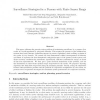Free Online Productivity Tools
i2Speak
i2Symbol
i2OCR
iTex2Img
iWeb2Print
iWeb2Shot
i2Type
iPdf2Split
iPdf2Merge
i2Bopomofo
i2Arabic
i2Style
i2Image
i2PDF
iLatex2Rtf
Sci2ools
IJRR
2007
2007
Surveillance Strategies for a Pursuer with Finite Sensor Range
This paper addresses the pursuit-evasion problem of maintaining surveillance by a pursuer of an evader in a world populated by polygonal obstacles. This requires the pursuer to plan collision-free motions that honor distance constraints imposed by sensor capabilities, while avoiding occlusion of the evader by any obstacle. We extend the three-dimensional cellular decomposition of Schwartz and Sharir to represent the four-dimensional configuration space of the pursuer-evader system, and derive necessary conditions for surveillance (equivalently, sufficient conditions for escape) in terms of this new representation. We then give a game theoretic formulation of the problem, and use this formulation to characterize optimal escape trajectories for the evader. We propose a shooting algorithm that finds these trajectories using the minimum principle. Finally, noting the similarities between this surveillance problem and the problem of cooperative manipulation by two robots, we present seve...
Four-dimensional Configuration Space | IJRR 2007 | Surveillance | Three-dimensional Cellular Decomposition |
| Added | 15 Dec 2010 |
| Updated | 15 Dec 2010 |
| Type | Journal |
| Year | 2007 |
| Where | IJRR |
| Authors | Rafael Murrieta-Cid, Teja Muppirala, Alejandro Sarmiento, Sourabh Bhattacharya, Seth Hutchinson |
Comments (0)

